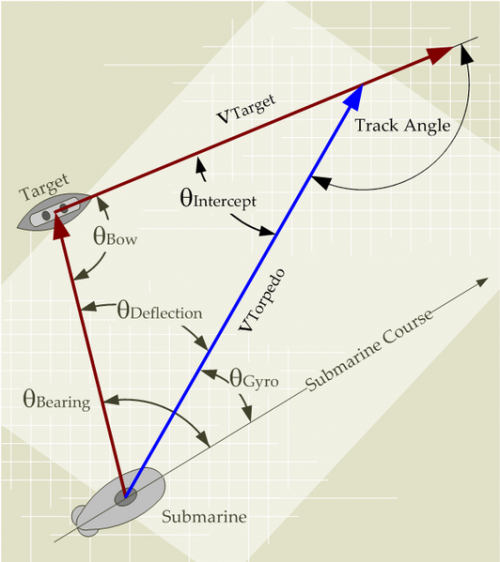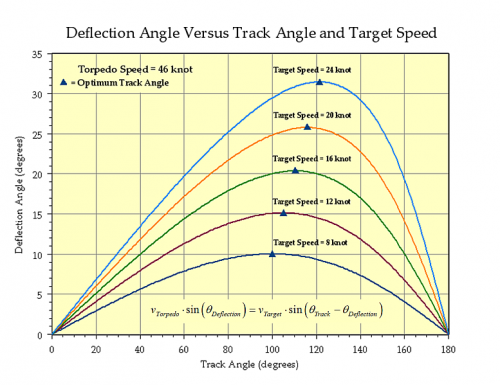Introduction
I received a message a few weeks ago from a docent at an East Coast museum. He was using an article I wrote for the Wikipedia years ago to demonstrate an application of trigonometry to high school kids. In that article, there was a figure that had a typo in it and he wanted it corrected so he could use it for his class. Since my Wikipedia writings have primarily been about military history, I was a bit surprise that he was using material I created to teach trigonometry. We traded some emails, I corrected the typo, and what he was doing turned out to be interesting. I decided it was worth covering here.
Background
The Wikipedia article I had written was about torpedo fire control during World War II. The docent was creating a simulation of World War II submarine combat in an effort to provide an exciting experience for kids that involved history and trigonometry – two of my favorite subjects. The kids would be able to get a feel for the difficulty of what their great-grandfathers were trying to do nearly 70 years ago. It's always fun trying to explain what they would have to go through to calculate the measurements needed. It often startles them to learn that it wasn't as simple as using a calculator to aid them with their calculations. Calculators weren't created until the 1960s, and even then you wouldn't be able to search for graphing calculators reviews by bestcalculators.net since the internet didn't exist either. You would have to work out everything you needed by hand and mental math. So, understanding trigonometry was paramount to make sure your calculation wasn't incorrect.
To understand the fire control problem, we need to define some terms. Figure 1 provides a visual illustration of the World War II torpedo fire control variables.
It turns out, that Figure 1 also illustrates the fire control problem. Equation 1 shows the equation that World War II sub skippers had to solve. If you look closely, it is a restatement of the law of sines.
| Eq. 1 | |
| substitute |
|
- vTarget is the velocity of the target.
- vTorpedo is the velocity of the torpedo.
- ?Bow is the angle of the target ship bow relative to the target bearing.
- ?Deflection is the angle of the torpedo course relative to the target bearing and is the critical value we are computing here.
- ?Track is the angle between the target ship's course and the torpedo's course.
These old torpedoes ran on a straight line that was determined by the angle, which we compute using Equation 2.
| Eq. 2 |
where is read from the submarine's compass and
was computed by the Torpedo Data Computer (TDC), an analog computer built to solve Equation 1.
Just like the TDC, we can solve Equation 1 for versus
to generate Figure 2. This is the figure that had the typo the docent wanted corrected. The typo of my original figure was in the equation that I had included as a note.
I originally saw this curve in the Submarine Torpedo Fire Control Manual. Sub skippers were told to try to fire with track angles at the optimum values, which are marked by small triangles in Figure 2. It was difficult for sub skippers to get an accurate estimate of the target ship's course
Conclusion
You never know where your work will turn up. When the docent finishes his simulation, I am going to travel to the East Coast and try it out.
If you are wondering how I ever got interested in this subject, it is a long story that goes back to my childhood. One critical part of the story involves the book "Clear the Bridge" by Richard O'Kane. I consider that book the finest description of World War II submarine combat that I have ever read (and I read them all). Admiral O'Kane's writing has a lively style that made quite an impression on a teenage boy.



I'm a former submarine officer. For years I carried around a small yellow card with all the 'official' Navy variable names used in the torpedo solution. Unfortunately - the card was lost at some point. On my nuke sub, we upgraded from a pure analog fire control system (MK113) to a digital system (Mk117) . The Mk113 was a descendant of the WWII TDC. I found your article and references very interesting. Thanks.
Hi,
I'm trying to write a program that calculates a target's relative position base on the TDC equations but my math is a little rusty and I'm not sure if I'm understanding the equations well or how to integrate them numerically. Do you think you could give me some pointers?
The equations I'm referring to are VIII and X on the TDC manual page 25:
http://www.hnsa.org/doc/tdc/pg025.htm
Thanks!
I had never seen that manual before -- what a great reference! I was so impressed that I put together a quick Mathcad worksheet that implemented the model. I decided to make it a blog post. I hope this information helps.
Mathscinotes
Pingback: Torpedo Data Computer Video | Math Encounters Blog
I recently rediscovered my academic weakness - math - and went on a rant about disliking it more than Jihadists... HOWEVER, it seems that I may be somewhat wrong in that statement due to my fascination with the men, equipment, and circumstances of a time not so long ago. Thanks for sharing... there may be hope for a peaceful coexistence with trig after all... 🙂
The historical applications of mathematics drive many of my blog posts. For example, I am working on one now about binary math and the ancient Egyptians. Thanks for stopping by!
mathscinotes
Very useful resources. Thank you.
I also have a useful book related to this topic.
Trigonometry For Dummies (2014).pdf - 7.2 MB
http://www.anafile.com/hxsuffw53wx2.html
Even as a working electrical engineer, trigonometry is the math I use the most. It is also the math I use the most as an amateur carpenter/woodworker.
mathscinotes